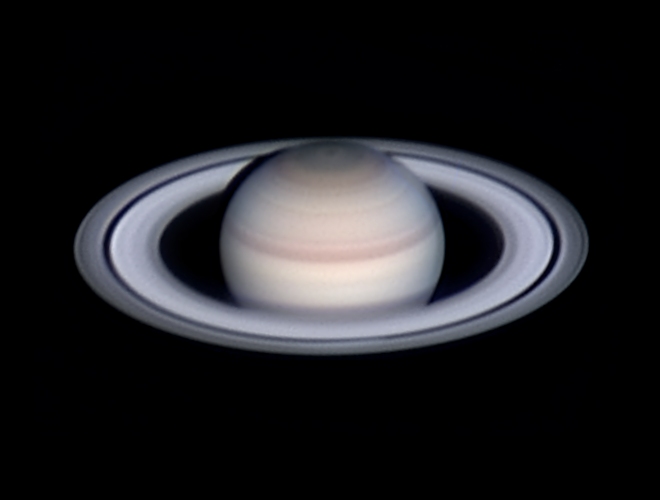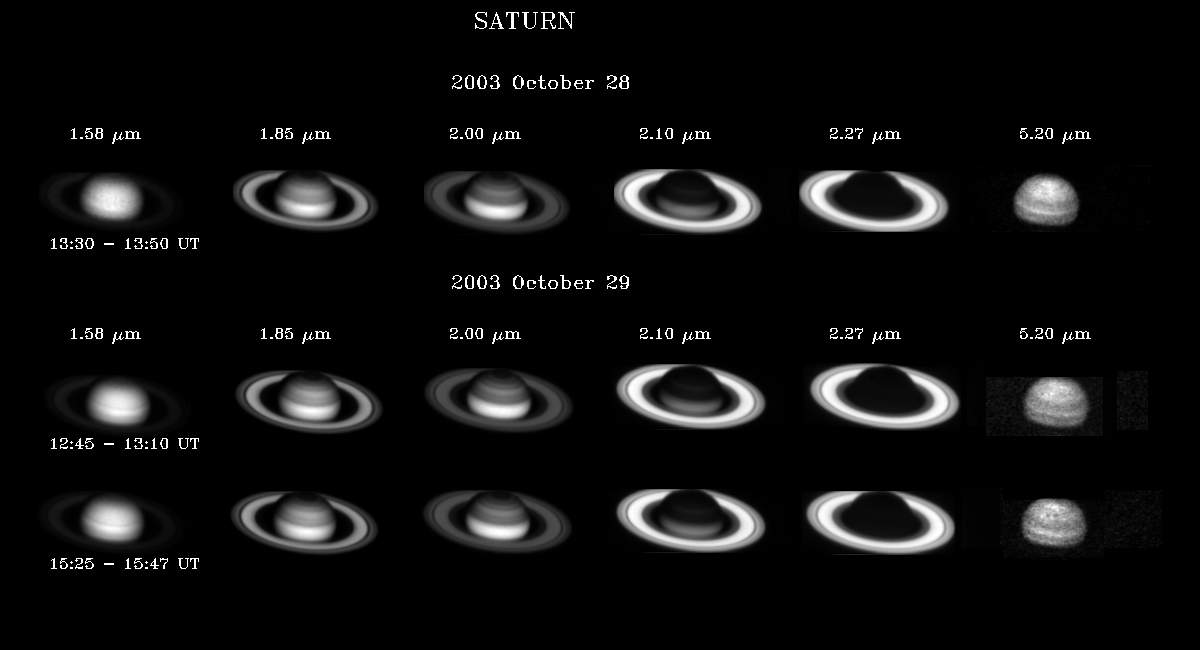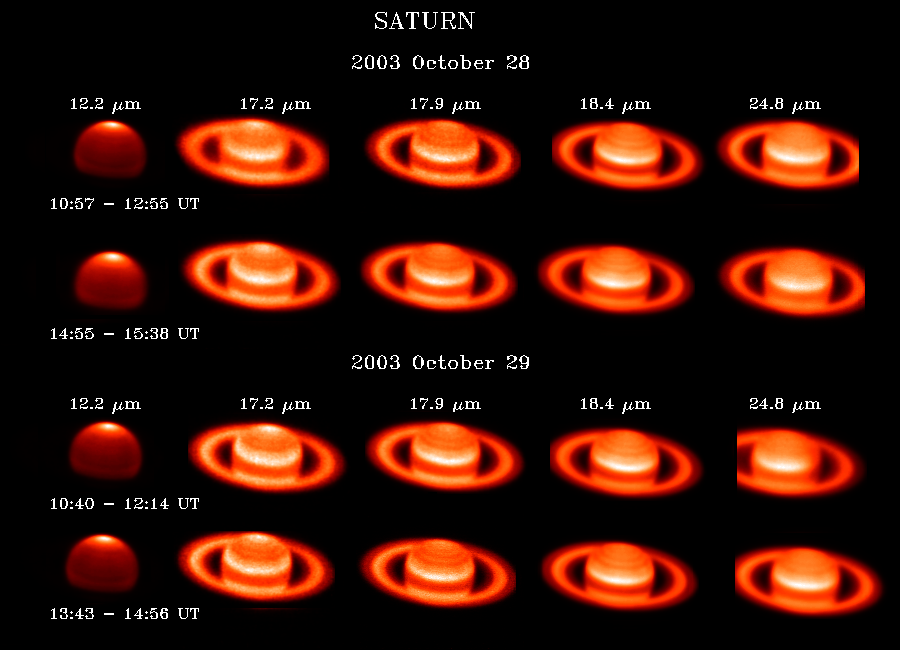土星 月惑星研究会 関西支部 (最新)
ALPO-Japan Latest
Saturn Image 2003/10/28(UT)
Damian Peach,IRTF
D.Peach,IRTF
|
Damian Peach (11" (28 cm) Celestron SCT:Philips ToUcam Pro)
|
|
Hi all
Here is a Saturn image obtained under very good seeing on October 28th, 2003 at 04:25 UT.
Taken with an 11" Schmidt Cassegrain @
f/31 and Philips ToUcam Pro. ~3000 images averaged. UT is centre of 600 sec window.
 On the 28th a small dark spot in the South Temperate Zone was recorded similar to the spots
captured earlier this month by Ed Grafton.
It was followed with rotation so must be real. Also mid-SEB bright spots were recorded...
On the 28th a small dark spot in the South Temperate Zone was recorded similar to the spots
captured earlier this month by Ed Grafton.
It was followed with rotation so must be real. Also mid-SEB bright spots were recorded...
 [Damian Peach: Loudwater, Buckinghamshire, UK.]
[Damian Peach: Loudwater, Buckinghamshire, UK.]
|
(NASA's Infrared Telescope Facility (IRTF))
|
|
Enclosed are two sets of images (gif format), from the the near-infrared
facility camera at NASA's Infrared Telescope Facility (IRTF), NSFCAM, and from
a guest camera/spectrometer operating at longer wavelenghts in the
middle-infrared.
 For the near infrared, 1.58 microns is sensitive to reflections from clouds
and 5.20 microns is sensitive to thermal emission from clouds. I would be
careful in attributing to reality the two dark "dots" on the second 5.20-micron
image taken on Sept 29. These were close to a blemish on the camera which we
hope to avoid the next time, although all images were taken as a series of
exposures which were "dithered" across the array. Going from 1.85 to 2.10
microns in wavelength, there is an increasing influence of gaseous absorption
from CH4 and H2, and so particulate "signatures" (features) arise from
particles that are at higher and higher altitudes in Saturn's stratosphere.
At 2.27 microns, so little light is reflected from particles in Saturn before
being absorbed by a gas that the rings are the only things that show up
prominently in the image.
For the near infrared, 1.58 microns is sensitive to reflections from clouds
and 5.20 microns is sensitive to thermal emission from clouds. I would be
careful in attributing to reality the two dark "dots" on the second 5.20-micron
image taken on Sept 29. These were close to a blemish on the camera which we
hope to avoid the next time, although all images were taken as a series of
exposures which were "dithered" across the array. Going from 1.85 to 2.10
microns in wavelength, there is an increasing influence of gaseous absorption
from CH4 and H2, and so particulate "signatures" (features) arise from
particles that are at higher and higher altitudes in Saturn's stratosphere.
At 2.27 microns, so little light is reflected from particles in Saturn before
being absorbed by a gas that the rings are the only things that show up
prominently in the image.
 For the middle-infrared, using guest camera MIRSI, I've used a false-color
reddish-white to remind myself that the images are comprised totally of thermal
emission. Going from 17.2 to 18.4 microns, emission arises from the upper
troposphere starting at 0.1 atmopsheres pressure down to 0.3 atmospheres
presssure. At 24.8 microns wavelength, most of the radiation is arising from
0.2 atmospheres pressure, but this wavelength is also sensitive to the ratio
para-H2 (atomic spins in the same direction) to para-H2 (atomic spins in the
opposite direction). At 7.85 microns (not shown) emission comes from a
well-mixed constituent methane (CH4) high in the stratosphere. The camera
which is relatively new, had a spectral leak from longer wavelengths where
the radiance is nearly a order of magnitude higher. At 12.2 microns, you
can also see stratopsheric emission from C2H6 (ethane) which shows the
product of stratospheric temperatures and the ethane abundance as a function
of planetary position. Note that the long southern summer has heated the
planet's arctic areas in the radiatively controlled upper troposphere
(see 17.2 microns) and stratosphere (see 12.2 microns). The rings are colder
than the planet, and so they show up poorly at 12.2 microns, but they are
more prominent in the longer wavlengths. The increase blurriness at
the longest wavlengths is a direct result of diffraction with ~20 microns
wavelength and a telescope with a primary mirror of a "mere" 3 meters in
diameter.
No processing was done to any of these images to enhance detail, or to recover
unblurred images before seeing or diffraction effects. Our next run is
scheduled in mid-December, and we will use the same two instruments.
Glenn Orton, Jet Propulsion Laboratory
Co-Investigator, Cassini Composite Infrared Spectrometer (CIRS)
[NASA's Infrared Telescope Facility (IRTF)]
For the middle-infrared, using guest camera MIRSI, I've used a false-color
reddish-white to remind myself that the images are comprised totally of thermal
emission. Going from 17.2 to 18.4 microns, emission arises from the upper
troposphere starting at 0.1 atmopsheres pressure down to 0.3 atmospheres
presssure. At 24.8 microns wavelength, most of the radiation is arising from
0.2 atmospheres pressure, but this wavelength is also sensitive to the ratio
para-H2 (atomic spins in the same direction) to para-H2 (atomic spins in the
opposite direction). At 7.85 microns (not shown) emission comes from a
well-mixed constituent methane (CH4) high in the stratosphere. The camera
which is relatively new, had a spectral leak from longer wavelengths where
the radiance is nearly a order of magnitude higher. At 12.2 microns, you
can also see stratopsheric emission from C2H6 (ethane) which shows the
product of stratospheric temperatures and the ethane abundance as a function
of planetary position. Note that the long southern summer has heated the
planet's arctic areas in the radiatively controlled upper troposphere
(see 17.2 microns) and stratosphere (see 12.2 microns). The rings are colder
than the planet, and so they show up poorly at 12.2 microns, but they are
more prominent in the longer wavlengths. The increase blurriness at
the longest wavlengths is a direct result of diffraction with ~20 microns
wavelength and a telescope with a primary mirror of a "mere" 3 meters in
diameter.
No processing was done to any of these images to enhance detail, or to recover
unblurred images before seeing or diffraction effects. Our next run is
scheduled in mid-December, and we will use the same two instruments.
Glenn Orton, Jet Propulsion Laboratory
Co-Investigator, Cassini Composite Infrared Spectrometer (CIRS)
[NASA's Infrared Telescope Facility (IRTF)]
 ALPO-Japan Latest
ALPO-Japan Latest

 Saturn Section
Saturn Section
 On the 28th a small dark spot in the South Temperate Zone was recorded similar to the spots
captured earlier this month by Ed Grafton.
It was followed with rotation so must be real. Also mid-SEB bright spots were recorded...
On the 28th a small dark spot in the South Temperate Zone was recorded similar to the spots
captured earlier this month by Ed Grafton.
It was followed with rotation so must be real. Also mid-SEB bright spots were recorded...
 [Damian Peach: Loudwater, Buckinghamshire, UK.]
[Damian Peach: Loudwater, Buckinghamshire, UK.] For the near infrared, 1.58 microns is sensitive to reflections from clouds
and 5.20 microns is sensitive to thermal emission from clouds. I would be
careful in attributing to reality the two dark "dots" on the second 5.20-micron
image taken on Sept 29. These were close to a blemish on the camera which we
hope to avoid the next time, although all images were taken as a series of
exposures which were "dithered" across the array. Going from 1.85 to 2.10
microns in wavelength, there is an increasing influence of gaseous absorption
from CH4 and H2, and so particulate "signatures" (features) arise from
particles that are at higher and higher altitudes in Saturn's stratosphere.
At 2.27 microns, so little light is reflected from particles in Saturn before
being absorbed by a gas that the rings are the only things that show up
prominently in the image.
For the near infrared, 1.58 microns is sensitive to reflections from clouds
and 5.20 microns is sensitive to thermal emission from clouds. I would be
careful in attributing to reality the two dark "dots" on the second 5.20-micron
image taken on Sept 29. These were close to a blemish on the camera which we
hope to avoid the next time, although all images were taken as a series of
exposures which were "dithered" across the array. Going from 1.85 to 2.10
microns in wavelength, there is an increasing influence of gaseous absorption
from CH4 and H2, and so particulate "signatures" (features) arise from
particles that are at higher and higher altitudes in Saturn's stratosphere.
At 2.27 microns, so little light is reflected from particles in Saturn before
being absorbed by a gas that the rings are the only things that show up
prominently in the image.
 For the middle-infrared, using guest camera MIRSI, I've used a false-color
reddish-white to remind myself that the images are comprised totally of thermal
emission. Going from 17.2 to 18.4 microns, emission arises from the upper
troposphere starting at 0.1 atmopsheres pressure down to 0.3 atmospheres
presssure. At 24.8 microns wavelength, most of the radiation is arising from
0.2 atmospheres pressure, but this wavelength is also sensitive to the ratio
para-H2 (atomic spins in the same direction) to para-H2 (atomic spins in the
opposite direction). At 7.85 microns (not shown) emission comes from a
well-mixed constituent methane (CH4) high in the stratosphere. The camera
which is relatively new, had a spectral leak from longer wavelengths where
the radiance is nearly a order of magnitude higher. At 12.2 microns, you
can also see stratopsheric emission from C2H6 (ethane) which shows the
product of stratospheric temperatures and the ethane abundance as a function
of planetary position. Note that the long southern summer has heated the
planet's arctic areas in the radiatively controlled upper troposphere
(see 17.2 microns) and stratosphere (see 12.2 microns). The rings are colder
than the planet, and so they show up poorly at 12.2 microns, but they are
more prominent in the longer wavlengths. The increase blurriness at
the longest wavlengths is a direct result of diffraction with ~20 microns
wavelength and a telescope with a primary mirror of a "mere" 3 meters in
diameter.
No processing was done to any of these images to enhance detail, or to recover
unblurred images before seeing or diffraction effects. Our next run is
scheduled in mid-December, and we will use the same two instruments.
Glenn Orton, Jet Propulsion Laboratory
Co-Investigator, Cassini Composite Infrared Spectrometer (CIRS)
[NASA's Infrared Telescope Facility (IRTF)]
For the middle-infrared, using guest camera MIRSI, I've used a false-color
reddish-white to remind myself that the images are comprised totally of thermal
emission. Going from 17.2 to 18.4 microns, emission arises from the upper
troposphere starting at 0.1 atmopsheres pressure down to 0.3 atmospheres
presssure. At 24.8 microns wavelength, most of the radiation is arising from
0.2 atmospheres pressure, but this wavelength is also sensitive to the ratio
para-H2 (atomic spins in the same direction) to para-H2 (atomic spins in the
opposite direction). At 7.85 microns (not shown) emission comes from a
well-mixed constituent methane (CH4) high in the stratosphere. The camera
which is relatively new, had a spectral leak from longer wavelengths where
the radiance is nearly a order of magnitude higher. At 12.2 microns, you
can also see stratopsheric emission from C2H6 (ethane) which shows the
product of stratospheric temperatures and the ethane abundance as a function
of planetary position. Note that the long southern summer has heated the
planet's arctic areas in the radiatively controlled upper troposphere
(see 17.2 microns) and stratosphere (see 12.2 microns). The rings are colder
than the planet, and so they show up poorly at 12.2 microns, but they are
more prominent in the longer wavlengths. The increase blurriness at
the longest wavlengths is a direct result of diffraction with ~20 microns
wavelength and a telescope with a primary mirror of a "mere" 3 meters in
diameter.
No processing was done to any of these images to enhance detail, or to recover
unblurred images before seeing or diffraction effects. Our next run is
scheduled in mid-December, and we will use the same two instruments.
Glenn Orton, Jet Propulsion Laboratory
Co-Investigator, Cassini Composite Infrared Spectrometer (CIRS)
[NASA's Infrared Telescope Facility (IRTF)] ALPO-Japan Latest
ALPO-Japan Latest
